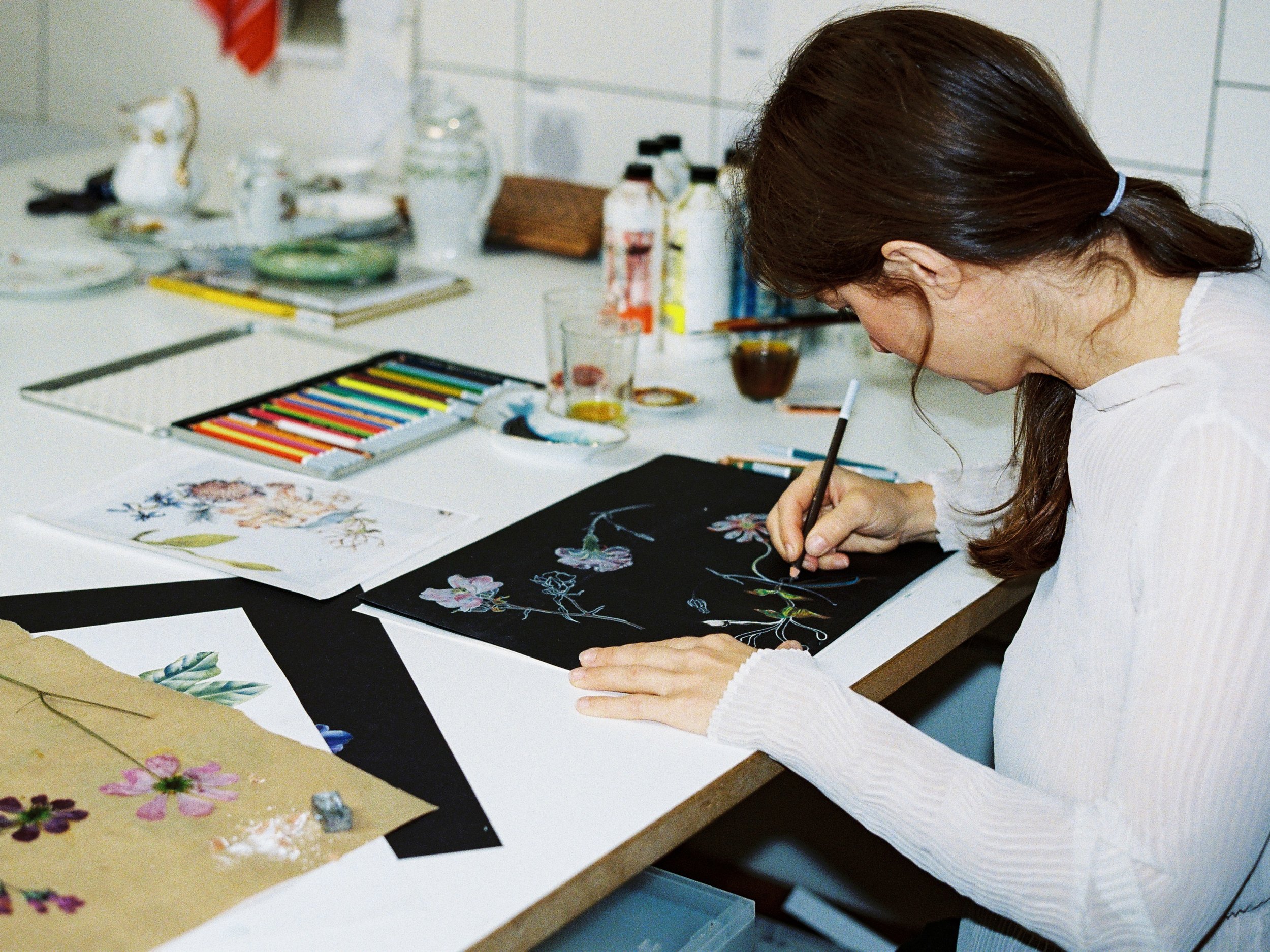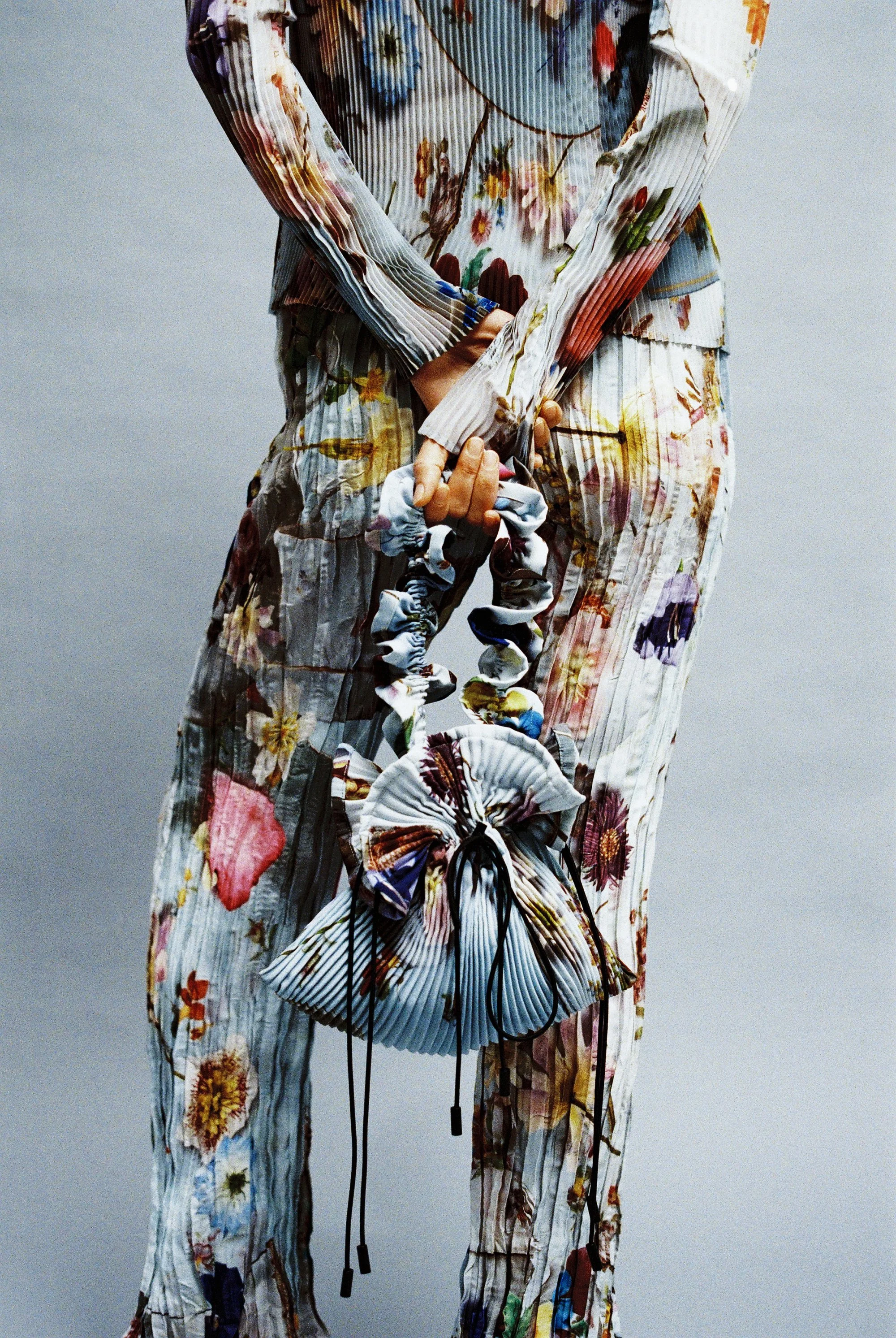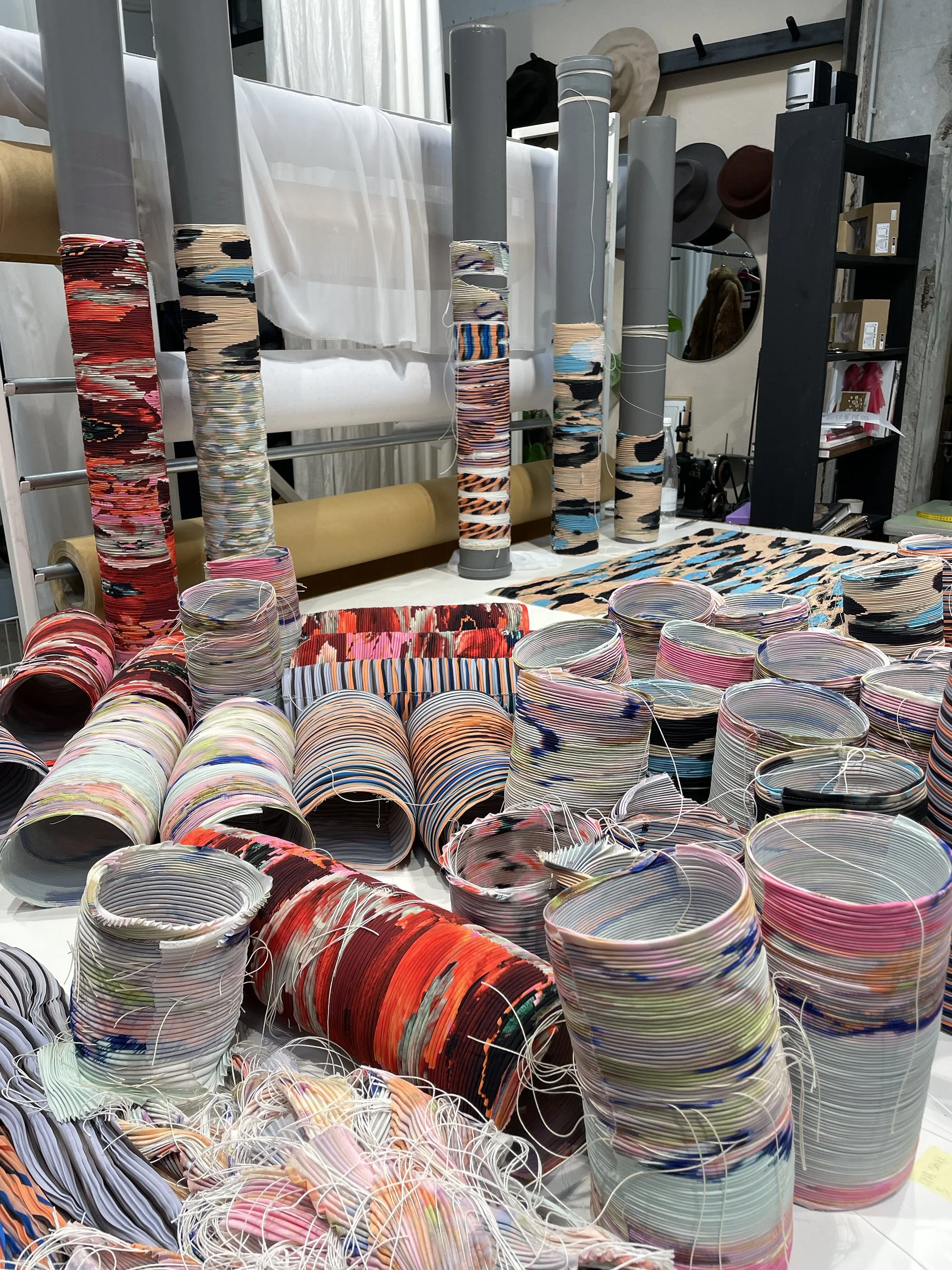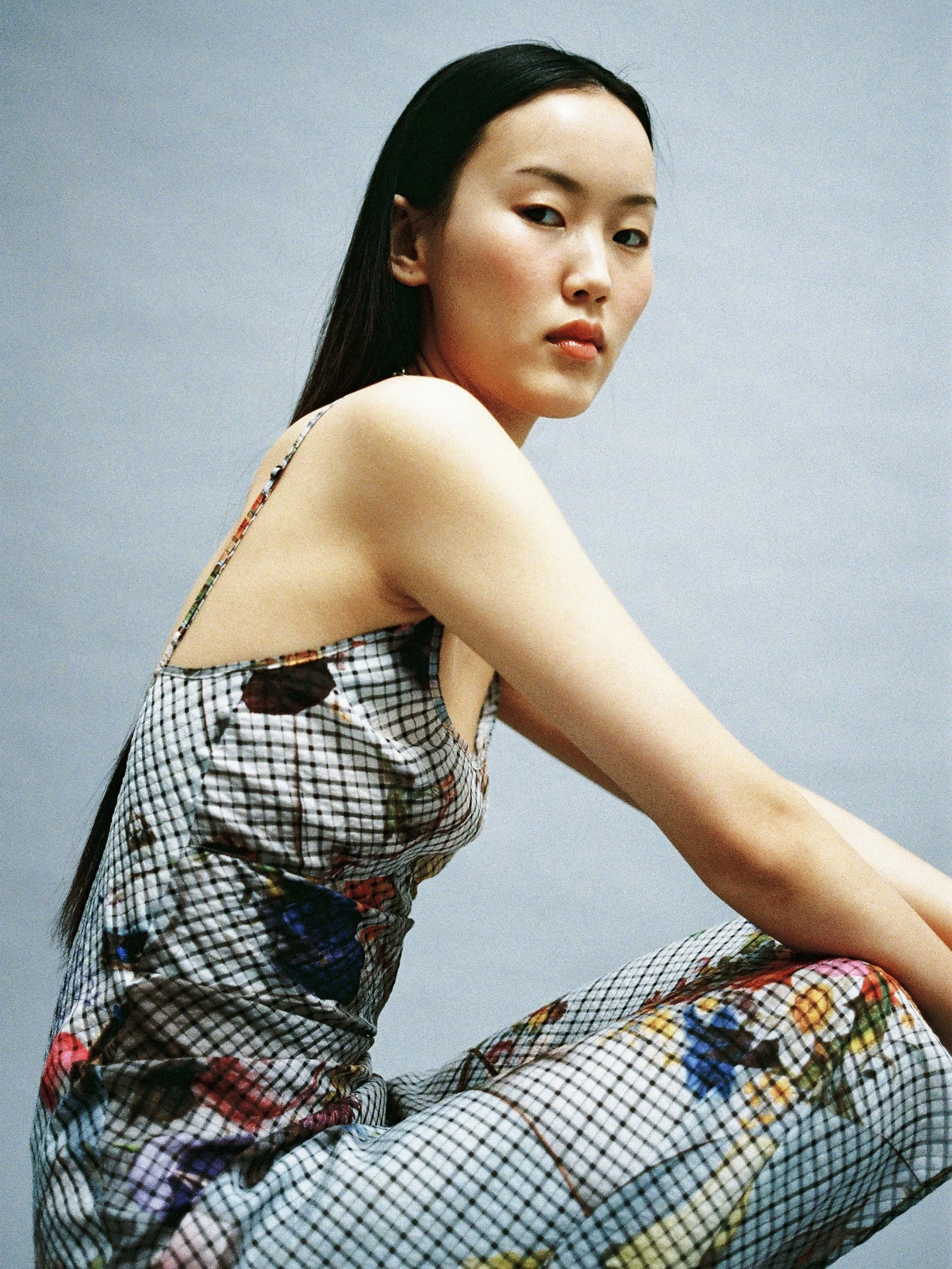Julia Heuer
It is with a genuine crush on her creations that we are delighted to present to you the world of Julia Heuer. This Paris-based fashion designer has captivated us with her whimsical prints and her innovative approach to pleating. By fusing the ancient Japanese art of shibori with the precision of digital printing, she has given birth to a singular aesthetic, both artisanal and deeply contemporary. After having worked for prestigious fashion houses, Julia Heuer now opens the doors to her world, a space where art, comfort, sustainability, and an authentic philosophy of community are intertwined. We hope this interview will inspire you as much as it has inspired us.
hello Julia, how are you? Can you tell us a bit about yourself, who you are, where you’re based, and what you do?
I’m originally from Germany, but I’ve been living in Paris for quite a few years now. I grew up in Germany and studied textile design in Stuttgart. After graduating, I spent several years working as a textile designer in Switzerland before eventually moving to Paris, where I founded my own brand. Your brand is known for its eccentric prints and innovative pleating.
How did you develop this signature aesthetic, and what was the “signature twist” you aimed to bring to traditional folkloric and historical references?
I first encountered Shibori while studying at the Design School in Denmark. This traditional Japanese resist-dyeing method is known for producing distinctive, organic fabric patterns. What captivated me, however, was its potential for pleating rather than dyeing. It struck me as a compelling fusion of craftsmanship and innovation - blending sculptural form with the accuracy of digital print techniques. This integration of age-old methods with contemporary technology reflects the core of my design philosophy.
Having worked with renowned fashion houses like Dior and Comme des Garçons, how did those experiences shape your approach to print design and ultimately inform your decision to launch your eponymous label?
During my time at the textile company Jakob Schlaepfer, I had the opportunity to develop prints that were supplied to major fashion houses, including Dior and Comme des Garçons. Those years felt like a second education - they taught me what a successful fashion print needs to convey, when it works, and why. That deep understanding laid a strong foundation for my own design journey, especially when I began merging handcrafted Shibori pleating with contemporary print design. It was a natural evolution that ultimately led me to launch my own label.
Your prints are all designed in-house, adding a truly unique and personal touch. Can you walk us through the creative process behind developing these patterns, from initial concept to the final design?
I usually begin by gathering inspiration-this can be anything from colors, paintings, or photographs to found imagery that sparks my curiosity or speaks to me emotionally. It’s a very intuitive process where I try to identify a common thread among these elements. From there, I start to imagine how to translate this theme into imagery, always considering how I can approach it in an analog way. Depending on the technique I choose, I then digitize the material and begin creating digital collages. Once a print starts to take shape, I develop up to ten different colorways and scale variations. After printing and pleating the samples, my team and I evaluate the results and select the most compelling options. The final step is understanding which print works best with which garment shape, ensuring that the design complements the silhouette and overall feel of the piece.
Given your roots in the Black Forest, and the organic, sculptural forms often seen in your pleats and shapes, how does nature influence your design process, specifically in the creation of your motifs and the overall silhouettes of your garments?
I think this is a process I’ve developed over time to give my prints a sense of warmth and uniqueness. Even though parts of the design are eventually handled digitally, it’s the analog steps that bring in the organic qualities-the depth, the texture, and the feeling that make the prints truly special. That tactile, imperfect quality is really important to me because it’s what ultimately creates the natural, sculptural feel we aim for in both the motifs and the silhouettes. It’s something that can’t be fully achieved through purely digital means-it needs that human, hands-on element to truly come to life.
Your Shibori pleating technique is central to your brand. Could you tell us more about the “ancient art of Arashi Shibori” and how you’ve adapted it to create the distinct sculptural shapes synonymous with Julia Heuer pieces?
Shibori is a traditional Japanese resist-dyeing technique used to create unique, organic patterns on fabric. What intrigued me most was using it for pleating instead of dyeing. It’s a beautiful marriage of craft and innovation-combining three-dimensional shaping with the precision of digital print design. For me, this hybrid approach of merging traditional techniques with modern technology perfectly embodies my design philosophy.
How do you foster this community of skilled women artisans who create your Shibori pleats, and what does their individual touch add to each garment?
I’ve been lucky to have a beautiful community of friends in Estonia who helped me build the Shibori production from the ground up in Tallinn. Since this kind of production didn’t exist in a traditional sense, it was something we had to create ourselves. It all started organically-one of those situations where you begin something, and everyone brings in their ideas, energy, and skills to help shape it. It grew from a network of friends and friends-of-friends within a larger creative circle who were genuinely excited about the project. Over time, it’s evolved into a group of skilled artisans. Shibori is a very hands-on, time-intensive craft, and you really have to love the process. Each pleater has developed their own particular way of working, their own strengths and techniques-which means every garment they touch carries a bit of their individuality. That personal imprint adds something truly special and irreplaceable to each piece.
Sustainability is a core value for your brand, with a focus on local production, fair wages, and recycled fabrics. How do you navigate the challenge of balancing traditional craftsmanship with modern sustainable practices, especially when some materials may not be eco-friendly?
As a small brand, it’s always a challenge to navigate the complexities of sustainability while staying true to traditional craftsmanship. But from the very beginning, I made a conscious decision to focus on handcrafted, distinctive textiles-pieces that carry emotional and artistic value. The way we execute this vision came quite naturally, but it depends heavily on building a strong network of suppliers who are not only open to working at a smaller scale but are also willing to go that extra mile. That level of commitment isn’t easy to find, and not everyone is willing to take on that challenge. Of course, this kind of production comes at a certain cost, which is reflected in the pricing of our garments. But for us, it’s essential in order to maintain quality, fair wages, and thoughtful production practices. We’re also continuously working to improve our materials. Our goal is to transition to 100% recycled polyester within the next year. As much as I’d love to make that switch immediately, we’re still dependent on what our suppliers are able to offer-and even more importantly, what actually works with our pleating and printing processes, as each fabric reacts differently and requires thorough testing. But I’m confident we’ll get there very soon.
You design garments that are ageless and slightly dramatic, yet prioritize comfort and practicality. How do you achieve this balance, ensuring your pieces seamlessly integrate into everyday life while still making a statement?
My pieces are designed to be fluid and comfortable, often offering a flexible fit that adapts to different body shapes and sizes within a single garment. When you wear one, it moves with you-it doesn’t restrict, but rather adjusts to your body, allowing for a sense of ease and freedom. At the same time, the bold colors, sculptural shapes, and pleated textures give each piece an expressive, slightly dramatic presence. This balance between comfort and statement is really key to the identity of the brand-and one of the reasons why women who buy a JH piece often come back. It becomes something they not only feel great in, but also feel seen in.
What kind of emotional connection do you hope your clients develop with their Julia Heuer pieces, and how does the handmade nature contribute to this?
I hope that my clients feel a deep connection to the story each piece tells-that wearing a Julia Heuer garment feels like becoming part of a community that values artistic expression, craftsmanship, mindful creation, and inclusivity. Because each piece is handmade, it carries a sense of individuality and care that goes beyond fashion. It’s not just about how it looks, but about how it makes you feel. I want people to feel confident, beautiful, and distinct when they wear it-like they’re expressing a part of their identity through something meaningful and unique.
Collaboration is fundamental to your creative ethos, extending beyond those who wear your pieces to artists, curators, and filmmakers. How do these collaborations enrich your brand’s storytelling and the overall artistic identity of Julia Heuer?
The idea of community has been very present in my thoughts lately, and it’s something I want to focus on even more moving forward. Community is about nurturing and valuing one another-supporting each other, learning together, and growing side by side. Collaborations with artists, curators, filmmakers, and other creatives are an essential part of this. They bring fresh perspectives, challenge my own ways of thinking, and open up new possibilities that wouldn’t have emerged from my process alone. These creative exchanges enrich the storytelling of the brand and deepen its artistic identity. They allow Julia Heuer to exist not just as a fashion label, but as part of a wider cultural conversation-always evolving, always curious.
Without giving away too many secrets, can you share any hints or teasers about the inspiration or themes for your upcoming collection?
Without giving too much away, I can share that we’ve been exploring an ancient textile technique as a central source of inspiration-both for the overall mood and especially for the prints. We’re also introducing new fabric developments that bring lightness and texture, all wrapped in a fresh, sun-drenched very Julia Heuer like color palette.
@julia__heuer
www.julia-heuer.com
pictures Yahui Wang - @yahui.folder















